As educators, one of our overarching goals is to support literacy communities where leisure reading can motivate all of readers to develop a lifelong love of reading. In this column, the members of the Children’s Literature and Special Interest Group, feature titles that have the potential to both support struggling readers and challenge more confident ones. For example, panel art might motivate reluctant readers while picture books with surprise twists offer unique challenges for more avid readers. Through the use of whitespace, illustrations, varied sentence length, complexity, and text features, the titles afford opportunities to scaffold the reading process. Through interesting storylines and the use of humor, these selections will provide wide appeal to both avid and reluctant readers.
Grades K-2
Bee, William. (2013). Digger Dog. Illus by Cecilia Johansson. Somerville, MA: Nosy Crow/Candlewick.
 With such a positive attitude and big smile, everyone needs a friend like Digger Dog. In this story, Digger Dog loves to dig for bones, but he also teaches the sound of the letter D, all about using comparatives and superlatives, and good adjectives. Most importantly, Digger Dog teaches the rewards of perseverance. On every page, Digger’s animal friends have his back as he tries harder and harder to dig up the biggest bone ever. A surprise-ending, four-page fold-out showing Digger’s bone digging success (a dinosaur digit!) inspires some primary-aged critical thinking as readers are encouraged to wonder about things they cannot see. Humorous illustrations in bright, sunny colors are enhanced by graphic polka dot backgrounds throughout the book. Visual cohesiveness partnered with consistent text patterns make this picture book a winner.
With such a positive attitude and big smile, everyone needs a friend like Digger Dog. In this story, Digger Dog loves to dig for bones, but he also teaches the sound of the letter D, all about using comparatives and superlatives, and good adjectives. Most importantly, Digger Dog teaches the rewards of perseverance. On every page, Digger’s animal friends have his back as he tries harder and harder to dig up the biggest bone ever. A surprise-ending, four-page fold-out showing Digger’s bone digging success (a dinosaur digit!) inspires some primary-aged critical thinking as readers are encouraged to wonder about things they cannot see. Humorous illustrations in bright, sunny colors are enhanced by graphic polka dot backgrounds throughout the book. Visual cohesiveness partnered with consistent text patterns make this picture book a winner.
—Emily Ritholz, Reading Specialist, Quarryville, PA
Cohn, Ariel. (2014) The Zoo Box. Illus by Aron Nels Steinke. NY: First Second.
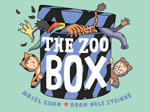 In this comic book style picture book, a brother and sister are left home alone to discover a suspicious box in the attic. The story starts with the parents reminding the children of bedtime, but the kids proceed to put on animal costumes (a tiger for the older sister, Erika). They then open the box labeled “do not open.” The children remain calm when first emerges an ostrich. From there, the story takes one fantastical turn after another. Young readers will enjoy the pacing of this book as they make sense of the bizarre “zoo” the children find themselves in. The amount of text varies from page to page which will help reluctant readers. There are wordless double-page spreads, eight panel spreads with only a few speech bubbles, and pages with plenty of text. This appealing offering will help build familiarity with the graphic novel format and also build confidence in young readers.
In this comic book style picture book, a brother and sister are left home alone to discover a suspicious box in the attic. The story starts with the parents reminding the children of bedtime, but the kids proceed to put on animal costumes (a tiger for the older sister, Erika). They then open the box labeled “do not open.” The children remain calm when first emerges an ostrich. From there, the story takes one fantastical turn after another. Young readers will enjoy the pacing of this book as they make sense of the bizarre “zoo” the children find themselves in. The amount of text varies from page to page which will help reluctant readers. There are wordless double-page spreads, eight panel spreads with only a few speech bubbles, and pages with plenty of text. This appealing offering will help build familiarity with the graphic novel format and also build confidence in young readers.
—Lesley Colabucci, Millersville University of Pennsylvania
Barnett, Mac (2014). Sam & Dave Dig a Hole. Illus by Jon Klassen. Somerville, MA: Candlewick Press.
 This irresistible picture book invites readers on an adventure with two boys and a dog. Armed with shovels, Sam and Dave are digging for “something spectacular.” As in the best picture books, readers needs the illustrations to understand the story. Humor is embedded in what the pictures convey that the text does not and the plot depends on pictures. The muted tones, varied page layout, and subtle details within the pictures are all key elements in this clever story. The book is meant to be read and re-read which will provide lots of practice for reluctant readers. In addition, young people will likely notice the ending twist before their teachers or parents.
This irresistible picture book invites readers on an adventure with two boys and a dog. Armed with shovels, Sam and Dave are digging for “something spectacular.” As in the best picture books, readers needs the illustrations to understand the story. Humor is embedded in what the pictures convey that the text does not and the plot depends on pictures. The muted tones, varied page layout, and subtle details within the pictures are all key elements in this clever story. The book is meant to be read and re-read which will provide lots of practice for reluctant readers. In addition, young people will likely notice the ending twist before their teachers or parents.
—Lesley Colabucci, Millersville University of Pennsylvania
DiCamillo, Kate. (2014). Leroy Ninker Saddles Up. Illus. by Chris Van Dusen. Somerville, MA: Candlewick Press.
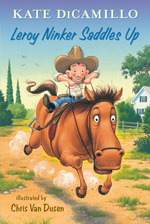 “Yippee-i-oh!” This transitional reader offers witty wordplay, a creative storyline, and endearing characters. Leroy Ninker has aspirations of becoming a cowboy. Even though he has a hat and nifty boots, he is missing one of the most essential items needed to be considered a “true” and “bona fide” cowboy—his very own horse. His search for a horse comes to fruition when he meets Maybelline, an oversized and friendly animal (with four large teeth). Leroy is instructed to follow some unusual rules. First, he must shower Maybelline with compliments or she won’t gallop or respond to any other commands. Second, Maybelline loves to eat, so he must feed her “plenty of grub” and finally, he should never leave Maybelline unattended. Unfortunately, Leroy leaves Maybelline alone and she runs away. Through a series of adventures and missed opportunities, Maybelline and Leroy finally reunite on Deckawoo Drive at the home of familiar characters (Mrs. Watson, Mercy, Stella and Frank). DiCamillo’s brilliant use of descriptive language and character development coupled with a heartfelt message about friendship make this a must-have for the classroom. The illustrations and the ‘horseshoe marker’ page numbers add to the light-hearted mood of the text. Teachers might be interested in viewing more information about the book, including a teacher’s guide at the publisher’s web site:
“Yippee-i-oh!” This transitional reader offers witty wordplay, a creative storyline, and endearing characters. Leroy Ninker has aspirations of becoming a cowboy. Even though he has a hat and nifty boots, he is missing one of the most essential items needed to be considered a “true” and “bona fide” cowboy—his very own horse. His search for a horse comes to fruition when he meets Maybelline, an oversized and friendly animal (with four large teeth). Leroy is instructed to follow some unusual rules. First, he must shower Maybelline with compliments or she won’t gallop or respond to any other commands. Second, Maybelline loves to eat, so he must feed her “plenty of grub” and finally, he should never leave Maybelline unattended. Unfortunately, Leroy leaves Maybelline alone and she runs away. Through a series of adventures and missed opportunities, Maybelline and Leroy finally reunite on Deckawoo Drive at the home of familiar characters (Mrs. Watson, Mercy, Stella and Frank). DiCamillo’s brilliant use of descriptive language and character development coupled with a heartfelt message about friendship make this a must-have for the classroom. The illustrations and the ‘horseshoe marker’ page numbers add to the light-hearted mood of the text. Teachers might be interested in viewing more information about the book, including a teacher’s guide at the publisher’s web site:
—Mary Napoli, Penn State Harrisburg
Hanlon, Abby. (2014). Dory Fantasmagory. New York, NY: Penguin Young Readers.
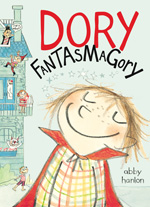 Imaginative, creative, humorous, and playful are just a few ways to describe this transitional chapter book. Dory, also known as Rascal, is the youngest sibling. Despite the fact her older brother and sister think she is a baby, her imagination and creative sense of play provide her hours of entertainment. Through a series of make-believe characters, Dory and her imaginary friend Mary, find ways to occupy their day (and also annoy her older siblings, Luke and Violet). Her sister threatens Dory that unless she stops acting like a baby, she will be snatched up by the ruthless Mrs. Gobble Gracker. Dory decides to defeat Mrs. Gobble Gracker by pretending to be a dog and engaging in other mischievous acts. Will she defeat Mrs. Gobble Gracker? Will her brother and sister finally play with her? What will be her next adventure? Dory is a well-developed and relatable character. The mix of words and illustrations (along with comic speech bubbles) make this an entertaining read-aloud.
Imaginative, creative, humorous, and playful are just a few ways to describe this transitional chapter book. Dory, also known as Rascal, is the youngest sibling. Despite the fact her older brother and sister think she is a baby, her imagination and creative sense of play provide her hours of entertainment. Through a series of make-believe characters, Dory and her imaginary friend Mary, find ways to occupy their day (and also annoy her older siblings, Luke and Violet). Her sister threatens Dory that unless she stops acting like a baby, she will be snatched up by the ruthless Mrs. Gobble Gracker. Dory decides to defeat Mrs. Gobble Gracker by pretending to be a dog and engaging in other mischievous acts. Will she defeat Mrs. Gobble Gracker? Will her brother and sister finally play with her? What will be her next adventure? Dory is a well-developed and relatable character. The mix of words and illustrations (along with comic speech bubbles) make this an entertaining read-aloud.
—Mary Napoli, Penn State Harrisburg
Grades 3-5
Gaiman, Neil. (2014). Hansel and Gretel. Illus. by Lorenzo Mattotti. New York, NY: RAW Jr. /TOON Books.
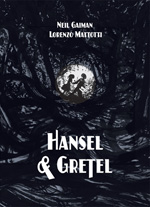 In this retelling of the classic fairy tale first published by the Brothers Grimm in 1812, Gaiman’s gift of descriptive language offers subtle nuances to provoke readers to question the underlying tone and messages of poverty, war, and abandonment. Gaiman adds an interesting ending where Hansel, Gretel, and their father live prosperous lives, never having to worry about food or shelter. He includes background information about the origin of the tale and a short bibliography of other Grimm collections. Moreover, he shares information about how his collaboration with illustrator Mattotti developed. Lorenzo Mattotti’s initial renderings were part of an exhibit to celebrate the Metropolitan Opera Production of Hansel and Gretel. His haunting illustrations immediately sear through the reader’s emotions. The wordless double page spreads contain swirls of blackness that support Gaiman’s text, but can also be ‘read’ independently. Gaiman & Mattotti’s rendition will intrigue and puzzle readers.
In this retelling of the classic fairy tale first published by the Brothers Grimm in 1812, Gaiman’s gift of descriptive language offers subtle nuances to provoke readers to question the underlying tone and messages of poverty, war, and abandonment. Gaiman adds an interesting ending where Hansel, Gretel, and their father live prosperous lives, never having to worry about food or shelter. He includes background information about the origin of the tale and a short bibliography of other Grimm collections. Moreover, he shares information about how his collaboration with illustrator Mattotti developed. Lorenzo Mattotti’s initial renderings were part of an exhibit to celebrate the Metropolitan Opera Production of Hansel and Gretel. His haunting illustrations immediately sear through the reader’s emotions. The wordless double page spreads contain swirls of blackness that support Gaiman’s text, but can also be ‘read’ independently. Gaiman & Mattotti’s rendition will intrigue and puzzle readers.
—Mary Napoli, Penn State Harrisburg
Judge, Lita (2014). Born in the Wild: Baby Mammals and their Parents. NY: Roaring Brook Press.
 This unique book presents 26 species of baby mammals. With a balance of storytelling through illustration, repetitive verses, and informational text this book offer a delightful experience for a wide variety of readers. Accordingly, the book can be read repeatedly and on many levels. The basic narrative pages contain just a simple sentence (The baby needs protection. The baby needs shelter) but the pages in between feature paragraphs devoted to each animal. These pages still maintain plenty of whitespace with bolder, colored text used to direct reader’s attention to the focus animal. In this way, readers can pick animals to focus on and read those sections. Readers with more motivation or endurance will find the back matter satisfying (containing further details on each animal, a glossary, sources, and a listing of websites). The art is an additional selling point for this book. The animals are drawn with a softness and realism that makes each one endearing.
This unique book presents 26 species of baby mammals. With a balance of storytelling through illustration, repetitive verses, and informational text this book offer a delightful experience for a wide variety of readers. Accordingly, the book can be read repeatedly and on many levels. The basic narrative pages contain just a simple sentence (The baby needs protection. The baby needs shelter) but the pages in between feature paragraphs devoted to each animal. These pages still maintain plenty of whitespace with bolder, colored text used to direct reader’s attention to the focus animal. In this way, readers can pick animals to focus on and read those sections. Readers with more motivation or endurance will find the back matter satisfying (containing further details on each animal, a glossary, sources, and a listing of websites). The art is an additional selling point for this book. The animals are drawn with a softness and realism that makes each one endearing.
—Lesley Colabucci, Millersville University of Pennsylvania
Spinelli, Eileen. (2014). Another Day as Emily. NY: Alfred A. Knopf.
 Eleven-year-old Suzy and 4-year-old Parker are pictured on the cover of this book as typical siblings. Suzy is easy to relate to as she spends her summer talking to her pet fish, participating in the library’s “Tween Time,” and becoming friends with an older boy named Gilbert. The character is tested when Suzy becomes jealous of the attention Parker gets for being a hero by calling 911 for a neighbor and gets rejected for a part in a play while her best friend is chosen. Suzy’s story maintains a hopeful tone throughout but her inner struggles with feel familiar with readers. Written in brief poems, the book moves fast. Some readers will want to take their time with individual poems (and possibly investigate Emily Dickinson further) while others will feel satisfied with the quick pace of the story.
Eleven-year-old Suzy and 4-year-old Parker are pictured on the cover of this book as typical siblings. Suzy is easy to relate to as she spends her summer talking to her pet fish, participating in the library’s “Tween Time,” and becoming friends with an older boy named Gilbert. The character is tested when Suzy becomes jealous of the attention Parker gets for being a hero by calling 911 for a neighbor and gets rejected for a part in a play while her best friend is chosen. Suzy’s story maintains a hopeful tone throughout but her inner struggles with feel familiar with readers. Written in brief poems, the book moves fast. Some readers will want to take their time with individual poems (and possibly investigate Emily Dickinson further) while others will feel satisfied with the quick pace of the story.
—Lesley Colabucci, Millersville University of Pennsylvania
Grades 6-8
Holt, K.A. (2014). Rhyme Schemer. San Francisco: Chronicle Books.
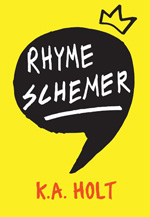 In the tradition of Love that Dog and Locomotion, K.A. Holt’s Rhyme Schemer explores the love/hate relationship between a boy and poetry. Kevin is in middle school and he is a bully. Ironically, he becomes a victim of bullies when his secret love of poetry is discovered. As “the poetry bandit,” Kevin rips out pages from books, then creates and pins up ingenious Found Poetry, which angers and baffles teachers while students cheer on this mysterious Robin Hood of words. Readers empathize with the emotional rollercoaster ride that is middle school. Who has not felt the way Kevin feels when he writes: “I am not a stone./I am not a rock./I am not a giant and unblinking and cold./ There is an earthquake./In my guts.” Kevin survives family problems, school disciplinary action, and self-esteem issues. Middle school students who struggle academically or emotionally will identify with Kevin. In the end, it is everyone’s angel, the school librarian who uplifts and supports Kevin. The book closes with a smile and a very important middle school reminder: Be Kind.
In the tradition of Love that Dog and Locomotion, K.A. Holt’s Rhyme Schemer explores the love/hate relationship between a boy and poetry. Kevin is in middle school and he is a bully. Ironically, he becomes a victim of bullies when his secret love of poetry is discovered. As “the poetry bandit,” Kevin rips out pages from books, then creates and pins up ingenious Found Poetry, which angers and baffles teachers while students cheer on this mysterious Robin Hood of words. Readers empathize with the emotional rollercoaster ride that is middle school. Who has not felt the way Kevin feels when he writes: “I am not a stone./I am not a rock./I am not a giant and unblinking and cold./ There is an earthquake./In my guts.” Kevin survives family problems, school disciplinary action, and self-esteem issues. Middle school students who struggle academically or emotionally will identify with Kevin. In the end, it is everyone’s angel, the school librarian who uplifts and supports Kevin. The book closes with a smile and a very important middle school reminder: Be Kind.
—Emily Ritholz, Reading Specialist, Quarryville, PA
Thomson, Ruth (2014). Photos Framed: A Fresh Look at the World’s Most Memorable Photographs. Somerville, MA: Candlewick.
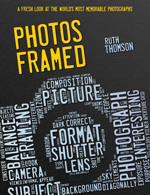 Photographs capture moments in time and serve as passports to understanding our past and capture our present. There is nothing quite like the experience of gazing at a photograph to convey emotion and its significance of a particular moment in time. In this well-organized nonfiction text, Ruth Thompson provides readers with a visual journey through history. The collection of 27 high quality photographic images feature an iconic self-portrait of photography inventor, Louis Daguerre (1844) to more contemporary images, including the Royal Wedding portrait of Prince William and Kate Middleton. The front matter includes a “note to readers” to pay close attention to the intricacies of each image. The table of contents includes headings, such as “portrait photography, nature photography, photography as art, and documentary photography.” Each double page spread contains information about the photograph and the photographer. There are also color coded questions to facilitate observation and discussion as well as text boxes: Blow Up and Zoom In. Each text box provides further opportunities for readers to observe and consider the details of each image. The adjacent page contains a full color photograph along with a relevant quote from the photographer that captures his/her keen perceptions to keep the reader interested and entranced. This is unquestionably an informative, well researched, and engaging nonfiction selection.
Photographs capture moments in time and serve as passports to understanding our past and capture our present. There is nothing quite like the experience of gazing at a photograph to convey emotion and its significance of a particular moment in time. In this well-organized nonfiction text, Ruth Thompson provides readers with a visual journey through history. The collection of 27 high quality photographic images feature an iconic self-portrait of photography inventor, Louis Daguerre (1844) to more contemporary images, including the Royal Wedding portrait of Prince William and Kate Middleton. The front matter includes a “note to readers” to pay close attention to the intricacies of each image. The table of contents includes headings, such as “portrait photography, nature photography, photography as art, and documentary photography.” Each double page spread contains information about the photograph and the photographer. There are also color coded questions to facilitate observation and discussion as well as text boxes: Blow Up and Zoom In. Each text box provides further opportunities for readers to observe and consider the details of each image. The adjacent page contains a full color photograph along with a relevant quote from the photographer that captures his/her keen perceptions to keep the reader interested and entranced. This is unquestionably an informative, well researched, and engaging nonfiction selection.
—Mary Napoli, Penn State Harrisburg
Grades 9-12
Lewis, J. Patrick & Lyon, George Ella. (2014). Voices from the March on Washington. Honesdale, PA: Wordsong.
 This book bridges non-fiction and poetry beautifully. Readers will learn about the March on Washington through poems in “imagined voices.” These poems present this historical event through the eyes of fictionalized characters—a third-grader from Washington, D.C. to a 16-year-old from Georgia to a Spelman College student. These voices are complemented by poems that capture the events of the time period, including poems devoted to Rosa Parks, Bayard Rustin, and Langston Hughes. The book starts with black and white photos, an in depth introduction, table of contents, and an initial poem titled “Reflection.” The end matter includes a guide to the voices, bibliography, websites, and two indices (one by voice and one by title). While the book has a satisfying arc read as a whole, the variety of poems and the detailed information about all the voices give this piece a special kind of accessibility to a wide range of readers for a wide range of purposes.
This book bridges non-fiction and poetry beautifully. Readers will learn about the March on Washington through poems in “imagined voices.” These poems present this historical event through the eyes of fictionalized characters—a third-grader from Washington, D.C. to a 16-year-old from Georgia to a Spelman College student. These voices are complemented by poems that capture the events of the time period, including poems devoted to Rosa Parks, Bayard Rustin, and Langston Hughes. The book starts with black and white photos, an in depth introduction, table of contents, and an initial poem titled “Reflection.” The end matter includes a guide to the voices, bibliography, websites, and two indices (one by voice and one by title). While the book has a satisfying arc read as a whole, the variety of poems and the detailed information about all the voices give this piece a special kind of accessibility to a wide range of readers for a wide range of purposes.
—Lesley Colabucci, Millersville University of Pennsylvania
Smith, Andrew. (2014). 100 Sideways Miles. NY: Simon & Schuster Books for Young Readers.
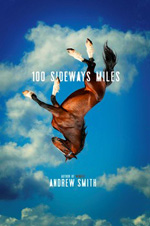 Finn Easton and Cade Hernandez are best friends. Their friendship is the heart of this novel which features first love, a tragic death, and the protagonist’s struggle epilepsy. In addition, Finn is also dealing with unwanted notoriety because of similarities he shares with a characters in his father’s famous cult-classic science fiction novel. While events in the story may seem bizarre and even disturbing, the deadpan dialogue between characters and classic teenage sarcasm make for a hilarious read. Fans of young adult literature will immediately “get” these characters and more reluctant readers will be drawn in by the charisma of the characters.
Finn Easton and Cade Hernandez are best friends. Their friendship is the heart of this novel which features first love, a tragic death, and the protagonist’s struggle epilepsy. In addition, Finn is also dealing with unwanted notoriety because of similarities he shares with a characters in his father’s famous cult-classic science fiction novel. While events in the story may seem bizarre and even disturbing, the deadpan dialogue between characters and classic teenage sarcasm make for a hilarious read. Fans of young adult literature will immediately “get” these characters and more reluctant readers will be drawn in by the charisma of the characters.
—Lesley Colabucci, Millersville University of Pennsylvania
These reviews are submitted by members of the International Reading Association's Children's Literature and Reading Special Interest Group (CL/R SIG) and are published weekly on Reading Today Online.